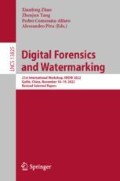Abstract
In recent years, high quality deepfake face images generated by Generative Adversarial Networks (GAN) technology have caused serious negative impacts in many fields. Traditional image forensics methods are unable to deal with deepfake that relies on powerful artificial intelligence technology. Most of the emerging deep learning-based deepfake detection methods have the problems of complex models and weak robustness. In this study, to reduce the number of network parameters, improve the detection accuracy and solve the problem of weak robustness of the detection algorithm, we propose a new lightweight network model SE-ResNet56 to detect fake face images generated by GAN. The proposed algorithm has high detection accuracy, strong robustness to content-preserving operations and geometric distortions, and strong generalization ability to different types of deepfake images generated by the same GAN.
Access this chapter
Tax calculation will be finalised at checkout
Purchases are for personal use only
References
Karras, T., Aila, T.: Progressive growing of GANs for improved quality, stability, and variation (2017)
Yang, X., Li, Y.: Exposing deep fakes using inconsistent head poses. In: International Conference on Acoustics, Speech and Signal Processing (ICASSP), Brighton, UK, pp. 8261–8265 (2019)
Li, Y., Chang, M.C.: In ICTU Oculi: exposing AI generated fake face videos by detecting eye blinking. In: IEEE International Workshop on Information Forensics and Security (WIFS), pp. 1–7 (2018)
Donahue, J., Hendricks, L.A.: Long-term recurrent convolutional networks for visual recognition and description. IEEE Trans. Pattern Anal. Mach. Intell. 39(4), 677–691 (2017)
Shan, M., Tsai, T.J.: A cross-verification approach for protecting world leaders from fake and tampered audio (2020)
Mo, H.X., Chen, B.L.: Fake faces identification via convolutional neural network. In: Workshop on Information Hiding and Multimedia Security, Innsbruck, Austria, pp. 43–47. ACM (2018)
Nirkin, Y., Wolf, L.: Deepfake detection based on discrepancies between faces and their context. IEEE Trans. Pattern Anal. Mach. Intell. (2021)
Li, L., Bao, J.: Face X-ray for more general face forgery detection. In: IEEE/CVF Conference on Computer Vision and Pattern Recognition (CVPR), pp. 5000–5009 (2020)
Matern, F., Riess, C.: Exploiting visual artifacts to expose deepfakes and face manipulations. In: IEEE Winter Applications of Computer Vision Workshops (WACVW), pp. 83–92 (2019)
Guo, Z.Q., Yang, G.B.: Fake face detection via adaptive residuals extraction network [EB/OL] (2021). https://www.researchgate.net/publication/341310624.Pdf
Chen, Z.K., Xie, L.X.: Mask-guided detection and reconstruction for defending deepfakes [EB/OL] (2021). https://arxiv.org/pdf/2103.14211.Pdf
Marra, F., Gragnaniello, D.: Do GANs leave artificial fingerprints. In: 2019 IEEE Conference on Multimedia Information Processing and Retrieval (MIPR), pp. 506–511 (2019)
Zhang, X., Karaman, S.: Detecting and simulating artifacts in GAN fake images. In: IEEE International Workshop on Information Forensics and Security (WIFS) (2019)
Wang, R., Ma, L.: A simple yet robust baseline for spotting AI-synthesized fake faces. In: International Joint Conferences on Artificial Intelligence (IJCAI 2020), pp. 3444–3451 (2019)
McCloskey, S., Albright, M.: Detecting GAN-generated imagery using color cues [EB/OL] (2018). https://arxiv.org/pdf/1812.08247.Pdf
Zhang, Y., Zheng, L.L.: Automated face swapping and its detection. In: IEEE 2nd International Conference on Signal and Image Processing (ICSIP), pp. 15–19. IEEE (2017)
Do, N.T., Na, I.S.: Forensics face detection from GANs using convolutional neural network. In: International Symposium on Information Technology Convergence (ISITC), pp. 376–379 (2018)
Afchar, D., Nozick, V.: MesoNet: a compact facial video forgery detection network. In: IEEE International Workshop on Information Forensics and Security (WIFS), Hong Kong, China, pp. 1–7. IEEE (2018)
Zhou, P., Han, X.T.: Two-stream neural networks for tampered face detection. In: IEEE Conference on Computer Vision and Pattern Recognition Workshops (CVPRW), pp. 1831–1839. IEEE (2017)
Hsu, C., Lee, C.: Learning to detect fake face images in the wild. In: International Symposium on Computer, Consumer and Control (IS3C), pp. 388–391 (2018)
Zhao, H.Q., Zhou, W.B.: Multi-attentional deepfake detection [EB/OL] (2021). https://arxiv.org/pdf/2103.02406.Pdf
He, K., Zhang, X.: Deep residual learning for image recognition. In: IEEE Conference on Computer Vision and Pattern Recognition (CVPR), pp. 770–778 (2016)
Hu, J., Shen, L.: Squeeze-and-excitation networks. In: IEEE Conference on Computer Vision and Pattern Recognition (CVPR), pp. 7132–7141 (2018)
Szegedy, C., Liu, W.: Going deeper with convolutions. In: IEEE Conference on Computer Vision and Pattern Recognition (CVPR), pp. 1–9 (2015)
Acknowledgments
Many thanks to the anonymous reviewers for their valuable comments to improve our work. This work was supported by the National Natural Science Foundation of China under Grant No. 61772416; Shaanxi province key research and development project, No. 2022GY-087.
Author information
Authors and Affiliations
Corresponding author
Editor information
Editors and Affiliations
Rights and permissions
Copyright information
© 2023 The Author(s), under exclusive license to Springer Nature Switzerland AG
About this paper
Cite this paper
Wang, X., Zhao, Z., Zhang, C., Bai, N., Hu, X. (2023). SE-ResNet56: Robust Network Model for Deepfake Detection. In: Zhao, X., Tang, Z., Comesaña-Alfaro, P., Piva, A. (eds) Digital Forensics and Watermarking. IWDW 2022. Lecture Notes in Computer Science, vol 13825. Springer, Cham. https://doi.org/10.1007/978-3-031-25115-3_3
Download citation
DOI: https://doi.org/10.1007/978-3-031-25115-3_3
Published:
Publisher Name: Springer, Cham
Print ISBN: 978-3-031-25114-6
Online ISBN: 978-3-031-25115-3
eBook Packages: Computer ScienceComputer Science (R0)

